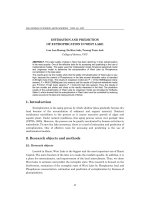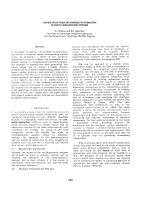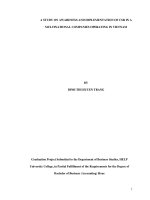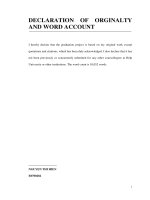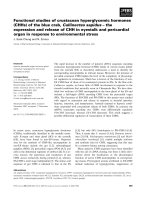Taxonomy and conservation of juglandaceae in cuc phuong national park
Bạn đang xem bản rút gọn của tài liệu. Xem và tải ngay bản đầy đủ của tài liệu tại đây (1.21 MB, 77 trang )
MINISTRY OF AGRICULTURE AND RURAL DEVELOPMENT
VIETNAM NATIONAL UNIVERSITY OF FORESTRY
STUDENT THESIS
Title:
TAXONOMY AND CONSERVATION OF JUGLANDACEAE IN CUC
PHUONG NATIONAL PARK
Major: Natural Resources Management
Code: D850101
Faculty: Forest Resources and Environmental Management
Supervisor: Assoc. Prof. Hoang Van Sam
Student: Dao Thi Duong
Student ID: 1453090979
Class: K59B Natural Resources Management
Course: 2014 - 2018
Advanced Education Program
Developed in collaboration with Colorado State University, USA
Ha Noi, 2018
Table of Contents
ACRONYMS
LIST OF FIGURE
LIST OF TABLE
ACKNOWLEDGMENT
ABSTRACT
I.
INTRODUCTION ............................................................................................................... 1
II. OVERVIEW OF THE RESEARCH ..................................................................................... 3
1.1. Worldwide research ......................................................................................................... 3
1.2
Research in Vietnam .................................................................................................... 4
1.3 Research in Cuc Phuong Park ........................................................................................... 6
III. GOAL AND OBJECTIVES ................................................................................................. 8
2.1 Goal ................................................................................................................................... 8
2.2 Objectives ......................................................................................................................... 8
IV. RESEARCH AREA ............................................................................................................. 9
4.1 Study area: ........................................................................................................................ 9
4.1.2 Natural resources ...................................................................................................... 12
4.1.2 Economic - Social conditions ................................................................................... 13
V. METHODOLOGIES ........................................................................................................... 15
5.1. Secondary data collection........................................................................................... 15
5.2. Field Investigation Method ........................................................................................ 15
5.3. Non-Field Investigation Method ................................................................................ 19
VI. RESULTS AND DISCUSSION ........................................................................................ 23
6.1 Species composition of the family Juglandaceae at Cuc Phuong National Forest ......... 23
6.2 Classification Key ........................................................................................................... 25
6.3. Some basic biological and ecological characteristics of Junglandace in CPNP ............ 27
6.3.1 Pteracarya tonkinensis Dode .................................................................................... 27
6.3.2 Alfaroa roxburghiana (Lindl. ex Wall.) Iljinsk ........................................................ 30
6.3.3 Platycarya strobilacea Siebold & Zucc .................................................................... 33
6.3.4. Carya sinensis Dode ................................................................................................ 35
6.4 Current status of conservation and development of Juglandaceae in Cuc Phuong
National Park ........................................................................................................................ 51
6.4.1 The researches .......................................................................................................... 51
6.4.2 Management and conservation of resources ............................................................ 51
6.4.3 Assessment the individual's changes of Juglandaceae ............................................. 53
6.5. Solution for conservation solutions for Juglandaceae species in Cuc Phuong National
Park ....................................................................................................................................... 55
6.5.1 Technical Solutions .................................................................................................. 55
6.5.2 Social-economic solutions........................................................................................ 56
6.5.3 Solutions of mechanism and policies to attract investment. .................................... 57
6.5.4 Completing the institution, policy, and law ............................................................. 58
VII. CONCLUSION AND RECOMMENDATION ................................................................ 59
7.1. Conclusion ..................................................................................................................... 59
7.2 Recommendations ........................................................................................................... 60
REFERENCES ......................................................................................................................... 61
APPENDICES .......................................................................................................................... 63
ACRONYMS
CPNP
Cuc Phuong National Park
IUCN
International Union for Conservation of Nature
EN
Endangered
Carya
Carya sinenesis
Hvn
Height
Hdc
Height under canopy
D1.3
Diameter at breast height
Dcrown
Crown diameter
LIST OF FIGURE
Figure 4.1: Cuc Phuong National Park ....................................................................................... 9
Figure 4.2: Location of Cuc Phuong National Park in the system of nature reserves of
Vietnam.....................................................................................................................................11
Figure 5.1: Plots in transect lines.............................................................................................. 16
Figure 6.1: Distribution of Carya sinenesis map ...................................................................... 24
Figure 6.2: Regeneration of Carya sinensis .............................................................................. 39
LIST OF TABLE
Table 6.1: Species composition of Juglandaceae ..................................................................... 23
Table 6.2: The distribution of Carya sinensis Dode ................................................................. 25
Table 6.3: The results of stem investigation ............................................................................. 36
Table 6.4: The size of leaflet in different position in compound leaf ...................................... 37
Table 6.5: The size of leaflet in different position of compound leaves .................................. 40
Table 6.6: The number of regeneration in natural and plantation forest .................................. 40
Table 6.7 Regeneration in three locations ................................................................................ 41
Table 6.8: Some criteria‟s of species belong to regeneration composition .............................. 43
Table 6.9: Stand volume in nine plots ...................................................................................... 44
Table 6.10: Volume, Diameter of canopy, the number of individuals of 6 species ................. 45
Table 6.11: Partners of Carya trees in plots............................................................................. 47
Table 6.12: The percentage of canopy cover in nine plots ....................................................... 49
Table 6.13: Investigation shrub and herb species ..................................................................... 50
Table 6. 14: Assess the change level of species belong to Juglandaceae in Cuc Phuong
National Park over past 3 years ................................................................................................ 54
ACKNOWLEDGMENT
First of all, I am grateful to teachers of Vietnam National University of Forestry for
supporting us to complete this research. I am deeply indebted to our supervisor Assoc. Prof.
Hoang Van Sam who always supported us and gave motives and suggested valuable ideas to
help us to accomplish this thesis. I would like to acknowledge all the members of
Experiments and Practicing Center of Forest Resource and Environment Management Faculty
for facilitating necessary equipment and providing us documents. I take this opportunity to
record our sincere thanks to all the members of the Faculty of Forest Resource and
Environment Management for their help and encouragement. Thank Cuc Phuong National
Park, Ninh Binh province management and local people for helping us during our researching
time Cuc Phuong, Nho Quan, Ninh Binh.
Hanoi, September 27th, 2018
Dao Thi Duong
ABSTRACT
This study found out information about diversity and conservation status of
Juglandaceae in Cuc Phuong National Park. Based on observation and measurements of
general characters, results indicated that there were 4 walnut species distributed in Cuc
Phuong National Park. They are Alfaroa roxburghiana (Lindl. ex Wall.) Iljinsk, Carya
sinensis Dode & Zucc, Platycarya strobilacea Siebold, Pteracarya tonkinensis Dode. Of
them, Carya sinensis Dode & Zucc listed in IUCN Red List, 2018 and Viet Nam Red Data
Book, 2007. Besides, based on the morphology of each species and Dichotomous Key, I
established Classification Key and species of four species of the walnut family. In addition,
this research also provides the distribution, morphology and ecological character of the
species. Last but not least, some solutions were proposed to preserve and develop walnut
species especially Carya sinensis Dode & Zucc in the study site.
I. INTRODUCTION
Vietnam is one of the centers of biodiversity of the world (Phuong, 1995). From the
results of scientific research on Vietnamese, many scientists at home and abroad have
recognized that. This nation is one of 10 countries in Asia with high biodiversity due to the
combination of many elements (Phuong, 1995).
However,
forest resources in Vietnam have been seriously degraded due to
various reasons such as the growing demand for forest products, the conversion of land use
purpose, over-exploitation, improper planning, war (Linh, 2016). According to data
published by Maurand P. in the project "Indochinese Forestry", in 1943 Vietnam had about
14.3 million ha of natural forest with 43.7% of its land area. The process of deforestation
occurred continuously from 1943 to the early 1990s, especially since 1976-1990 the area of
natural forest decreased sharply, in only 14 years the forest area decreased by 2.7 million
ha, The annual loss of nearly 190,000 ha (1.7% / year) and the forest area decreased to the
lowest level of 9.2 million ha with a coverage of 27.8% in 1990 (Tran Van Con, 2001).
Deforestation also means a loss of genetic diversity in plants and animals. Forests are
currently concentrated only in protected areas and national parks.
Cuc Phuong National Park belongs to the National Park system in Vietnam, was
established in 1962 under decision No Dec 72/TTg of the Prime Minister, and dated 7 July
1962. This decision decreed the establishment of a 25,000 ha protected forest (MARD
1997). Cuc Phuong National Park is the first and the largest national park of Vietnam lies
along the borders of three provinces of North Vietnam including Ninh Binh, Hoa Binh,
Thanh Hoa. There are an estimated 2,000 different species of flora and the 450 species
fauna account for 38% of national fauna (Linh, 2016). According to the survey of Cuc
Phuong national park in 2008, the flora is quite a treasure with a wide variety with 2,234
species of 917 genera, 231 families of 7 orders. Many of them are of high value: 430
medicinal plant species, 229 edible plant species, 240 species can be used as medicine,
1
dye, 137 species can provide tannin, etc; 13 species are listed in Vietnam Red Data Book
2000 and IUCN Red List 2004. Some outstanding species are Dalbergia tonkinensis,
Parashorea chinenis, Erythrophloem fordii, and Nageia ffeyri, Carya sinenis.
Cuc Phuong National Park has a rich flora with tropical rainforest, and there are
many studies on the area. However, studies that classify and conserve them to identify the
status and distribution of non-native species, particularly those of high economic value in
conservation, are limited and undesirable. Besides, the over-exploited Juglandaceae species
of local peoples that lead to the decrease of walnut species in Cuc Phuong National Park.
They used wood to build houses, and make the furniture. Seeds of some species are
valuable foods with high nutritional contents and oil extraction (Carya sinensis Dode). The
leaves of some species are toxic to insects and fish, so they can be used as pesticides
(Alfaroa roxburghiana (Lindl. ex Wall.) Iljinsk, Pterocarya tonkinensis Dode). The peels
of fruits are used to produce activated carbon. Some parts of the tree such as bark, root
bark, leaf, and seed and fruit shells are used as traditional medicines. Therefore, some
species are reduced due to narrow distribution, small numbers of individuals and listed
Vietnam Red Data Book 2007 and IUCN Red List 2018 such as Carya sinensis Dode is a
native species of Vietnam, facing a number of threats, including loss of habitat and
distribution without focusing, overexploitation, low natural regeneration.
From the above-mentioned reality, I chose the subject “Taxonomy and
Conservation of Juglandaceae in Cuc Phuong National Park” To provide databases on
plant diversity, as a basis for the conservation and development of biological resources at
the national park.
2
II. OVERVIEW OF THE RESEARCH
1.1. Worldwide research
Botany in the world is very rich and diverse with approximately 250,000 species of
high plants (Linh, 2016), including Juglandaceae accounted for 60 species.
The walnut family (Juglandaceae) originated during the Eocene epoch of the
Paleogene period about 65 to 55 million years ago. The climate during the Eocene was
subtropical and moist throughout North America and Europe. This family consists of eight
genera including Alfaroa, Carya, Cyclocarya, Engelhardia, Juglans, Oreomunnea,
Platycarya, and Pterocarya with 50 species (Paul S. Manos and Donald E.Stone, 2004)).
However, some taxonomists report as few as seven genera (Cyclocarya omitted) and as
many as nine genera (Annamocarya added) that include 60 species (Rogers, 2004; Manos
và el at 2007). Most member of this family distributed in the North, Center and South
America, Mexico, Europe, and Asia. Rogers (2004) also concluded that there were one
species of Platycarya recorded in Vietnam.
Takhtajan (1997) in his book “Diversity and classification of flowering plants”
introduced family Juglandaceae with three subfamilies. Platycarioideae including one
genus (Platycarya). The species in this genus have bracts of female flowers persisting on
the axis of inflorescence that was not dispersed with the fruits. Vessels with simple
perforations. Engelhardtioideae have four genera (Alfaroa, Alfaropsis, Oreomunea, and
Engelhardia). These species in this subfamily had bracts of the female flowers fall together
with the fruits, three-lobed. Vessels with scalariform or simple perforations. Juglandoideae
had three genera (Cyclocarya, Pterocarya, and Juglans) with bracts of the female flowers
fall together with the fruits, entire. Vessels with simple perforations (Takhtajan, 1997).
Thanks to the wind dispersed fruits in some genera of Juglandaceae that play important
role in the reproductive ecology and the early diversification of this family. The
3
morphological characteristics of the winged fruits in some genera provide many useful
characters in their identification. (Takhtaijan, 1977)
1.2 Research in Vietnam
According to results claiming the number of Juglandaceae, Chinese …. Plant is
typical. This document shows that Juglandaceae includes 24 species belonging to 7
genuses and many described different sub-geniuses. In which, there are 11 species and
other related ones determined to be contributed in Vietnam (Wu & Raven 1999).
Researches on Juglandaceae classification of the author within the country is not
considerable, according to “Cay co Viet Nam” (Pham Hoang Ho, 2003). (Ho, 2003)
In this project, 4 genera and 12 species were recorded to be in Juglandaceae. The
author described the information about morphological characteristics and distribution place
of species in brief. In comparison with Chinese plant, Cay Co Viet Nam claimed that the
number of Juglandaceae species present in Vietnam is more than 1 species. In the
document of Vietnam Woodforest (Tran Hop, 2002), the Juglandaceae was introduced
with detailed information about morphological characteristics and use values of 8 species
typical of 5 genera. However, this project has not mentioned the total number of species in
Juglandaceae distributed in Vietnam yet. Instead, the document summarized the
information about distribution and values of species. Those species which are mainly
distributed in the north of Vietnam are 800-100 meters in height. The Vietnam Red Book
(2007) described detailed information about identification features, biological and
ecological characteristics, value distribution and state for 2 species belonging to
Juglandaceae both of which are in danger, including Annamocarya sinensis (Dode) J.
Leroy and Carya tonkinesis Lecomte. Both of 2 above species provide qualified wood for
building, presses seed of fatted oil, fruit shell for processing proactive coal.
4
The document of Vietnam wood trees (2009) described the information about
morphological characteristics of 5 genera in Jugladaceae. The document also stated that
most of the species are distributed in the north of Vietnam such as Lai Chau, Son La, Vinh
Phuc and central provinces as Thanh Hoa, Nghe An. The species in genus Carya, Juglans
và Pterocarya are often humidity-demanding and mostly concentrate on rivers, streams,
valleys or foot-hill. The species in the genus Platycarya are suitable for distribution in
limestone mountain.
In terms of use values, most of the tree species in Juglandaceae is fairly diverse in
utilization use of wood and other products. The wood from medium to good at quality can
be used in building and making furniture. The seed of some species can be used to make
food with high nutrients (Carya, Juglans). The leaves of some species are rather dangerous
to insects and fishes, so the local people use them to kill bugs or worms (Engelhardia,
Pterocarya). The peel is used to produce proactive coal. Some parts as the bark of stem and
root, leaves, seed and the peel of fruit are used in some traditional prescription, especially
in some parts of an ethnic minority. Some tree species are used as the host tree to release
Coccinellidae feeding Kerria lacca (Tran Hop, 2002; Rogers, 2004; Vietnam Redbook,
2007; Trieu Van Hung and partners, 2007; Vo Van Chi, 2012, Bich and partners, 2006)
With respect to conserving species in Junglaceae, the typical project mentioned
most is “Prospects of danger plant preservation in Vietnam” (Chien and partners, 2006).
This project researched on the prospect of conserving 6 plant species in Vietnam which are
considered to be in a threat about species composition and habitat, including Annamocarya
sinensis. The research showed that Annamocarya sinensis was facing some threats such as
loss of habitat, lack of intensive distribution, over-exploitation, and the weak ability of
natural generation. The research is specific about solving 3 main problems: natural
generation of Annamocarya sinensis in the population of natural forest, especially
5
development prospect of species, the process and the most important period in the life
circle of species.
1.3 Research in Cuc Phuong Park
Cuc Phuong is the first national park founded in Vietnam on July 7th, 1962.
Through over 45 years of protection and development, the scientific project left us a
variety of precious reference sources. Some typical projects are listed as follows:
“The first inventory step of Cuc Phuong vegetation forest cover” by Le Viet Loc
(1965) who determined and set up the map of 11 dominant types. (Loc, 1965).
“Cuc Phuong Plant biodiversity” (1996) by Phung Ngoc Lan, Nguyen Nghia Thin,
Nguyen Ba Thu all of who listed 1944 species in 912 genuses, 219 families, 86 kingdoms
of 7 phylums in high plant hierarchy. In which, there are many species used to make
medicine. However, they have yet to be described in detailed but only be statically listed
by species. (Phung Ngoc Lan, Nguyen Nghia Thin, Nguyen Ba Thu, 1996).
From 1998 to 2008, the program for International Cooperative Biodiversity Groups
(ICBG) sponsored by National Institutes of Health (NIH), based on NIH Grant 1-UO1TW01015-01 and NIH Grant 2 U01 TW001015-08. Cuc Phuong National Park operated
with Ecology and Organism Resource Institution of Vietnam Science and Technology
Institution, Chicago University, Fiel Museum, USA to investigate and making thousands of
capillary high-hierarchies plant specimen. (D.Detal, 2004).
Based on collected samples in 2004, botanists in co-operative office published the
book “Seed Plants of Cuc Phuong National Park. A documented Checklist”. This is the
book listing most enough and scientifically 1.926 high-hierarchies precocious plant species
of Cuc Phuong National Park. Unlike the previous researches on the plant of Cuc Phuong
National Park, in the above book, each of species was assured by at least 1 extracted plant
specimen. (D.Detal, 2004).
6
Since 1998, the precocious plant of Cuc Phuong was concerned and researched by
International Cooperative Biodiversity Groups (ICBG) on many aspects as species
diversity, ecological distribution, preservation state, traditional medicine utilization and
potentials of medicine resource. “A classification hand list of Cuc Phuong precocious
plant” was the first result of ICBG co-operating with Cuc Phuong National Park.
Partly synthesizing research results over 45 past years, the authors Truong Quang
Bich, Nguyen Manh Cuong, Do Van Lap, D.D Soejarrto, Mai Van Xinh, Nguyen Huy
Quang introduced an image book named “Some popular species in Cuc Phuong” including
294 species that are described in detailed about images, morphology and use values .
In general, from the beginning till now, there have been various research projects
on Cuc Phuong. Cuc Phuong National Park owns high plant biodiversity typical of the
tropical rainforest. However, researches on classification and conservation to determine the
current state and distribution of out-of-nature species (especially species owning high
economic values) are still limited and have yet to have conservative value. Resulting from
the practical demand of conservation and development project on forest ecology of
National Park, the topic “Taxonomy and Conservation of Juglandaceae in Cuc Phuong
National Park” was researched in order to provide document basis on plant biodiversity,
making a ground basis for conserving and developing organism resources in National Park.
7
III. GOAL AND OBJECTIVES
2.1 Goal
To provide information about diversity and conservation status of Juglandaceae in
Cuc Phuong National Park.
2.2 Objectives
To identify species composition and distribution of Juglandaceae in Cuc Phuong
National Park.
Identification of some basic biological and ecological character of the species,
description.
To provide solutions for conservation and development of Juglandaceae in Park.
8
IV. RESEARCH AREA
4.1 Study area:
Figure 4.1: Cuc Phuong National Park
(Source: From Cuc Phuong National Park)
4.1.1. Natural condition
4.1.1.1 Geographic location
Cuc Phuong NP is located with the geographical coordinates from 20º14' to 20º 24'
North latitude and from 105º 29' to 105º 44' East longitude. The NP has a total area of
22,200 ha with the length of 30 km and the width of 6 to 10 km, situated in the
administrative area of 3 provinces of Ninh Binh, Hoa Binh, and Thanh Hoa.
3.1.1.2 Topographic
Cuc Phuong National Park lies at the south-eastern extent of a limestone range that
runs north-west to Son La province. This limestone range predominantly comprises karst, a
marine in origin and perhaps 200 million years old. The section of the limestone range
9
encompassed by the national park rises sharply out of the surrounding plain, to elevations
of up to 636 m.
This section is around 10 km wide and 25 km long and has a central valley running
along.
3.1.1.3 Soil types
The Cuc Phuong soil is derived from limestone, with schist, argillite, and quartz.
There are different kinds of soil varying from the foot to the top of the limestone
mountains including Rensin red, Greiss-yellow, red-yellow, black, margaliste-ferralite
yellow. On the Non-limestone Mountains, there are several types of soil, such as ferralite
yellow and ferralite yellow-red. In general, the soil of Cuc Phuong is of a light texture and
is generally moist because of its rather favorable character of imbibition.
10
Figure 4.2: Location of Cuc Phuong National Park in the system of nature reserves of Vietnam
Source: Cuc Phuong National Park
4.1.1.4 Climate elements
Cuc Phuong has a monsoon, tropical climate with an average annual temperature
during the year of 24.7°C, with a minimum 16.6°C, and a maximum of 39°C.
The average rainfall and average year of Cuc Phuong are from 1800 mm to 2400
mm, and 2138 mm representatively. It is relatively heavy rainfall compared to the
surrounding area. The rainy season begins late of April to November. There are 8 months
11
that have more than 100mm rainfall. The month has the highest rainfall in September with
the average rainfall of 410.9 mm, while in December, January, February, and March has
not 50 mm. of rainfall. Although the dry season has 4 months, it is very different from the
rainy season. Low rainfall and low temperatures make the climate in Cuc Phuong relatively
harsh in winter
4.1.1.5 Hydrological
The karst topography exerts a dominant influence on drainage patterns in Cuc
Phuong. Most of the water that the national park receives is quickly absorbed by a complex
underground drainage system common to mature karst landscapes, often emerging from
springs on the lower slopes flanking the national park. For this reason, there are no natural
ponds or other standing bodies of water within the national park, and there is only one
permanent watercourse, the Buoi River. This river bisects the western end of the national
park from north to south and feeds the Ma River, the major river in Thanh Hoa province.
4.1.2 Natural resources
4.1.2.1 Forest vegetation
Cuc Phuong is very diverse in flora species composition structure. With such an area
equaling to 0.07 % out of the total area nationwide, it accounts for 57.93 % of flora
families, 36.09 % of genetic diversity and 17.27 % of the species as compared with total
figures for the country. Cuc Phuong NP has 20,473 ha of forest out of the total land area of
22,200 ha (accounting for 92.2 %). The vegetation cover here is the type of evergreen
tropical rainforest. According to Thai Van Trung (1976), Cuc Phuong belongs to the type
of closed humid evergreen tropical rainforest. Cuc Phuong has a considerable area of
primary forest, mainly focused on the limestone mountain area and at valleys in the center
of the NP.
12
Survey results of recent years (2008) recorded 2,234 species of 917 genera, 231
families of 7 orders (Table 1). Many of them are of high value: 430 medicinal plant
species, 229 edible plant species, 240 species can be used as medicine, dye, 137 species
can provide tannin, etc; 13 species (table 5) are listed in Vietnam Red Data Book 2000 and
IUCN Red List 2004. Some outstanding species are Dalbergia tonkinensis; Parashorea
Chinensis, Erythrophloeum fordii; and Nageia fleyri. There are 11 endemic plant species
(table 2), including Camellia cucphuongensis; Begonia cucphuongensis; Pistacia
cucphuongensis; Amorphophallus dzui; Vietorchis aurea; Carex trongii, etc.
4.1.2.2. Fauna
The invertebrate fauna in Cuc Phuong is even more abundant and diverse. In the
period from 2000-2008, about 7,400 invertebrate animal samples have been collected,
including 1,670 species and species types of insect, 14 crustacean species, 18 species and
types of species of myriapod, 16 spider-shaped species, 52 species and species types of
annelid, 129 species and species types of mollusc, and many other species of lower animal.
However, it is due to the fact that the lower animal species did not get much attention and
research on these species have been rarely done.
4.1.2 Economic - Social conditions
4.1.2.1 Population and labor
Cuc Phuong National Park is located in the region of 14 communes at the park buffer
zone until 31/12/2008 that include two main ethnic groups Muong ethnic accounted for
76.6% of the total population in the region and Kinh ethnic is accounted for 23.4% (
Survey data (2009). Total population in 14 communes is 74,118 people with 17,028
households. Among them are the residents living in 8 communes inside the national park
with 1801 people with 396 households.
13
4.1.2.3. Forestry Production
Presently, majority areas of the 14 buffer zone communes have been contracted to
manage by households including some protected area near the adjacent border between
core zone area and buffer zone. Forest regeneration and restoration have been done a little
and low efficiency, partly due to less investment, partly because of policies the interests of
people from forest regeneration and recovery. In recent years, with support from the
project (661), project KFW4, forest area increased steadily every year. In 2008, 312 ha
planted with acacia trees, Eucalyptus and a number of valuable species such as Chukrasia
tabularis, Canarium album, Aquilaria crassna, Cinnamomum balansae.
4.1.2.4. Industry and craft industry production
The buffer zone communes do not have a social base of any major industry, only a
small number of establishments and manufacturing industries such as quarrying, baked
brick, production of a home appliance. The number of industrial workers and craft industry
accounted for only 2.3% of total employees in total of production values is very low.
Weaving craft industry, bamboo, and rattan in Thanh My commune is losing due to lack of
material and over cheap foreign products.
14
V. METHODOLOGIES
5.1. Secondary data collection
Using a method to collect existing data about Cuc Phuong National Park
geographic condition, the current status of fauna and flora biodiversity, forest areas;
economic and social condition of surrounded communes.
5.2. Field Investigation Method
Preparation
- Prepare tools: Measuring tapes, compass, nylon tape, calipers, camera, laptop,
GPS…;
- Prepare personal tools to need for the field trip to research;
- Prepare documents and maps related to the natural condition, social, economic in
CP national forest.
Apply silvicultural investigation methods to study the distribution, growth and
morphological characteristics of Juglandaceae plants, namely:
5.2.1. Transect line method
- The transect linear used to illustrate a particular gradient or linear pattern along
the communities of Juglandaceae species. They provide a good way of being able to
clearly visualize the changes taking place along the line. The transect line has a design in
the map depending on the discussion with local experts and ranger of CPNP. Using GPS to
determine the distribution of species in the map of Cuc Phuong National Park‟s flora. On
the investigation start observation to identify species and statistical indicators about species
need investigation. About the unidentified name, collect the sample to the evaluation later.
- The transect lines survey, we selected 4 transect lines for Cuc Phuong NP as
follows:
- Route 1: From the main gate to Dong Con
- Route 2: From Dong Con to Park Center (Bong sub-station).
- Route 3: Bong Center to thousand years old trees.
15
- Route Line 4: Bong Center to Sau ancient tree
Figure 5.1: Plots in transect lines
5.2.2 Sample plot method
Based on the transect line survey results, locate up sample plots of 500 m2
(25x20m), these plots are based on the principle: must be placed in locations that have the
higher representativeness.
Regeneration investigation
In each transect, we observe the regeneration status of those species. Attention is
around the seed tree. Then, establish quadrat 4 m2 (2mx2m) to survey around seed tree (in
the crown and outside the crown to evaluate the regeneration status of Juglandaceae plant
species on the research area.
16
- Investigate the height of regenerated species by ruler or tape measure.
- A survey on the quality of plant growth using the naked eye observation, based on
the experience of the investigator. The quality of regenerated species is divided into 3
levels:
+ A: the Good tree is the tree canopy well and equally development, body straight,
not disabled, not diseased.
+ B: the Normal tree is the tree grows more slowly than good, not crooked,
diseased, topless and less disability.
+ C: Bad trees are skewed tree canopy, leaf concentrate on top, poor growth, many
defects, diseases, and pets.
- Collect the regeneration date of Juglandaceae plants then determine the seedlings
which are regenerated from seeds or stump sprouts. If the original tree grows straight and
that means regeneration from seed. If the stem grows curves and below often have to wind,
it is regenerated from stump sprout.
(The results are recorded in table 2 in appendixes)
High trees investigation ( Results recorded on Table 1 in Appendixes)
In the plot, the details are described such as locations, slope, exposure, altitude, to
identify the growth indicators of tall tree storey:
17


